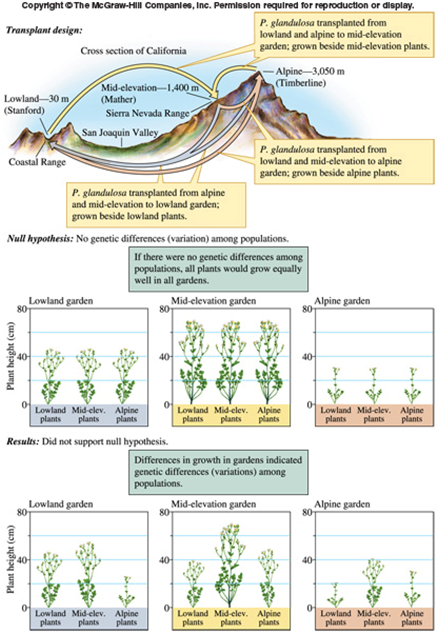
Chapter 4 -- Population Genetics

Potentila glandulosa
common Garden experiments
This species of plant occurs at different elevations in California, and was sampled from a rather low elevation in the coastal ranges, at mid elevation in the Sierra Nevada to the east, and at the peak in the Sierras. The mid-elevation plants are the largest, with the low elevation next and then the alpine individuals being the smallest (makes sense with the shorter growing season). The investigators brought all three morphs together at all three altitudes and investigated the results of growing the three morphs under the same conditions at the three different altitudes. Differences did NOT completely disappear when grown together, indicating that there are genetic differences between the populations. Interestingly, the mid-elevation plants actually did the best at all three elevations, with the lowland morph doing better than the alpine morph at the low elevation site (not surprising), and the alpine (high elevation morph doing better than the lowland morph at both mid and high elevations in the Sierras.

Types of Selection
Stabilizing selection occurs in rather stable (duh!) conditions and selects against the extremes on either side of the normal curve for variation, narrowing the range of variation.
Directional selection occurs in habitats where the conditions are changing in a particular direction, getting wetter/drier/warmer/colder, and select against individuals at one extreme and for individuals on the other, shifting the curve.
Disruptive selection requires unusual circumstances where the middle of the road specimens are selected against and both extremes are selected for. Although this is probably rare WITHIN a single location, this likely happens with regularity between populations.
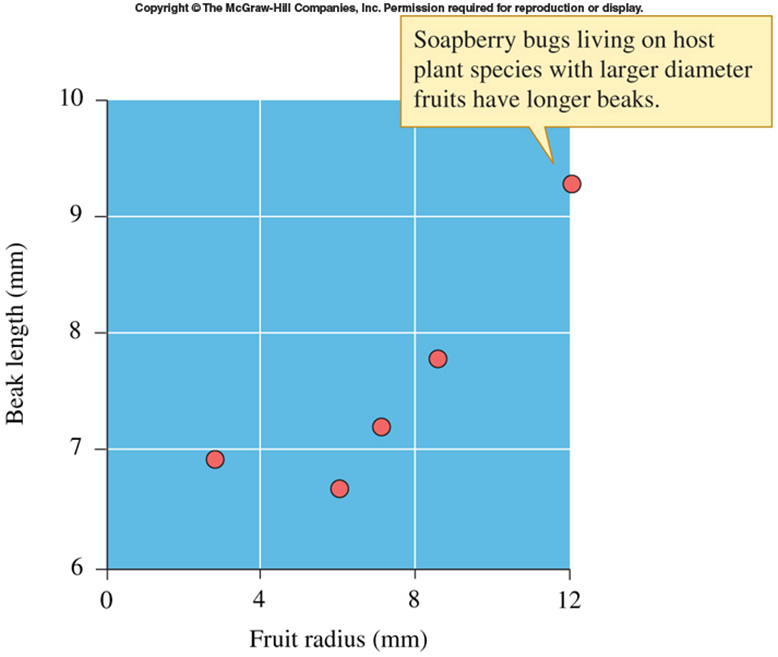
Directional selection in Soapberry bugs: when a new plant (Chinese Golden Rain Tree) was introduced into the U.S. with a thinner fruit than balloonvine, one of the Soapberry bugs usual foodplants, beak length shortened through time. Resources that would be allocated to a longer beak on the balloonvine can now be used for other things.
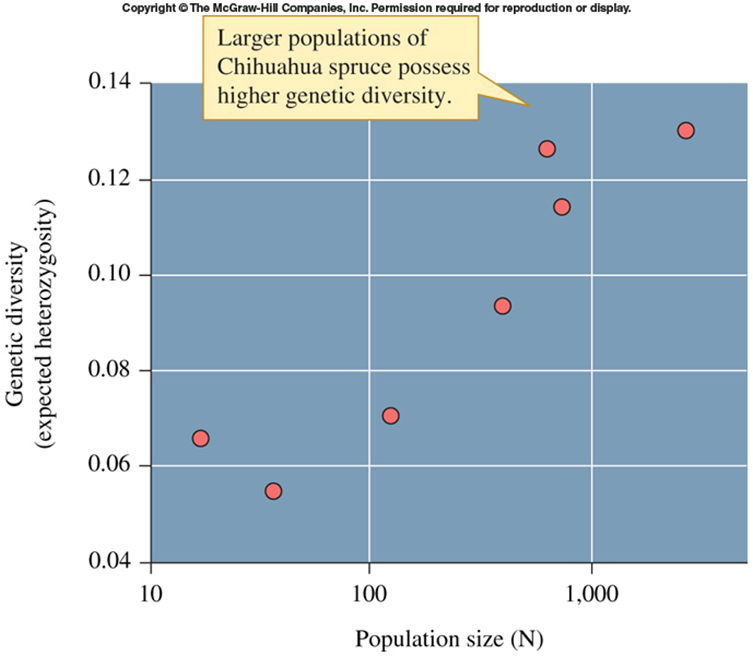
Population size, genetic drift and overall genetic diversity. Larger populations with more individuals have higher genetic diversity (fewer alleles have been LOST due to drift).
Chapter 5 -- Temperature relations
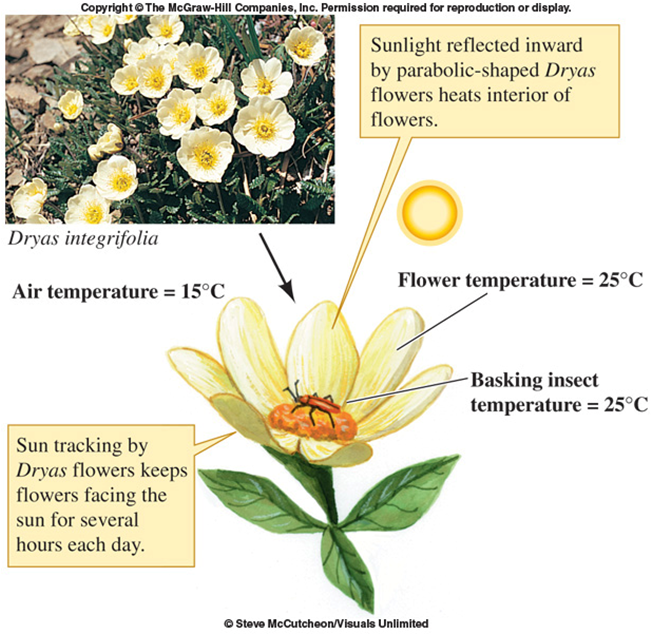
A subarctic flower and regulation of temperature. The flower (Dryas integrifolia) has large pale petals that reflect sunlight (and heat) toward the center of the flower. Whereas the air temperature may be 15 degrees C, the center of the flower may be ten degrees C warmer, and any insects visiting the flower may be warmed as well. The flower can actually track the sun, and therefore remaing facing the sun for many hours each day.
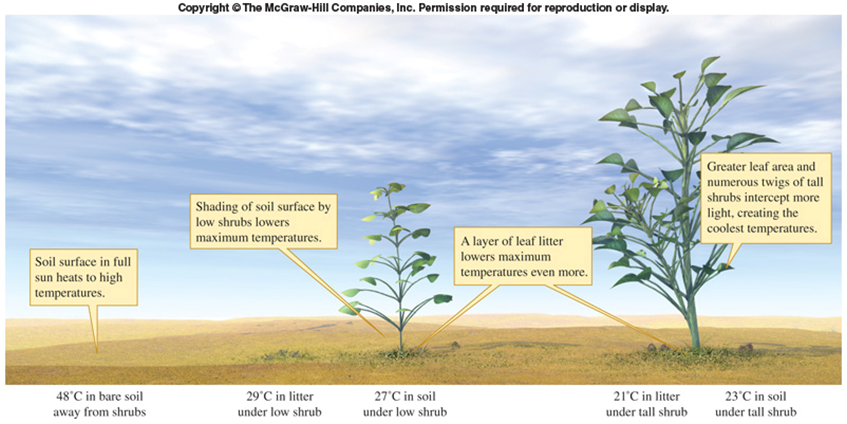
Temperature and vegetation. In the desert (and other dry hot regions), the bare soil temperature in the hot part of the day may reach near 50 degrees C. Under small plants and in the leaf litter around them, the temperature can be 20 degrees C cooler, and under larger plants nearly 30 degrees C cooler. In other words, shade and leaf litter are important moderators of temperature!
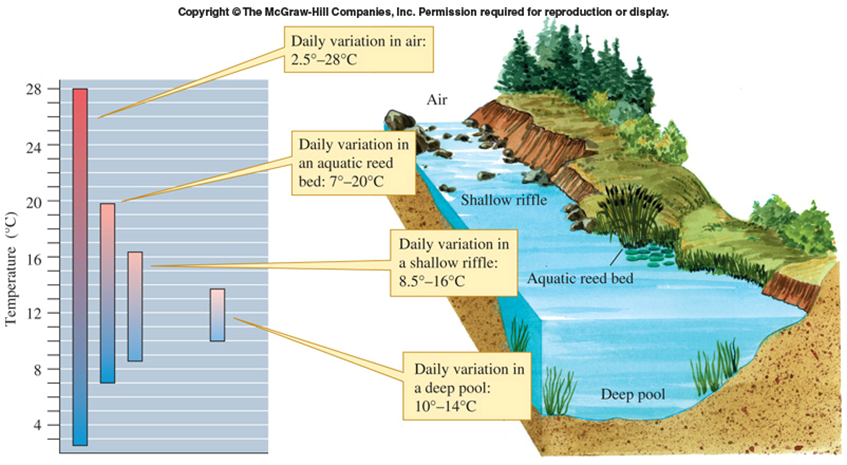
Water has a moderating effect on temperature fluctuations during the day. In this example, the temperature swings from nearly 30 degrees C during the heat of the day to near freezing at night. In the reed bed along the bank, the high temperature reached is only about 20 degrees C and the low is 7 degrees. In the shallows, the temperature swing is from 16 to 9 degrees C, and in a deep pool the temperature swing is just from 14 to 10 degrees C. Water definitely buffers the extremes that can be seen in the terrestrial environment.
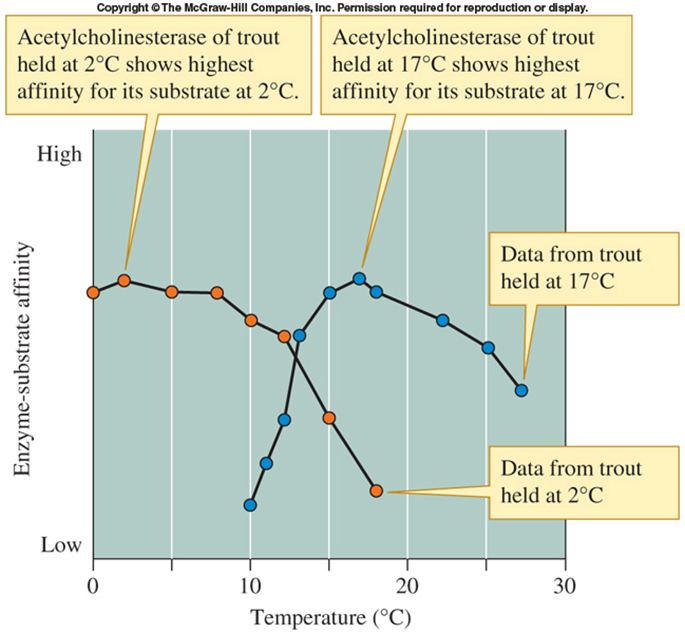
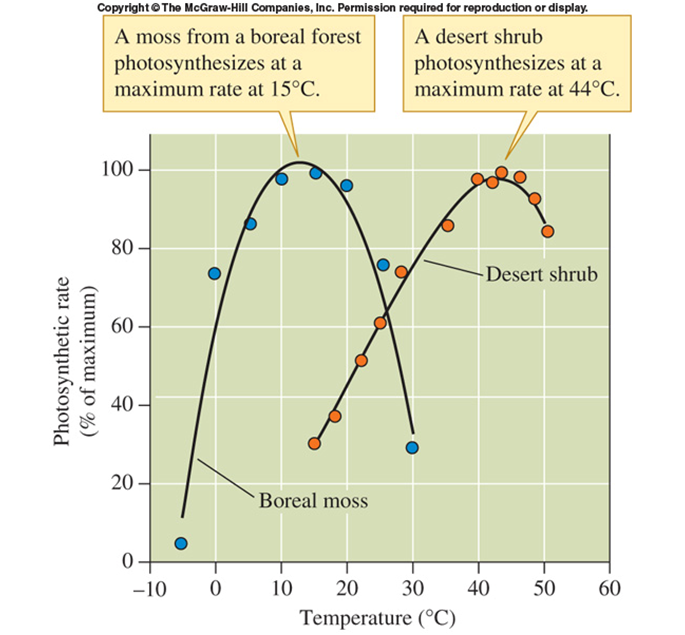
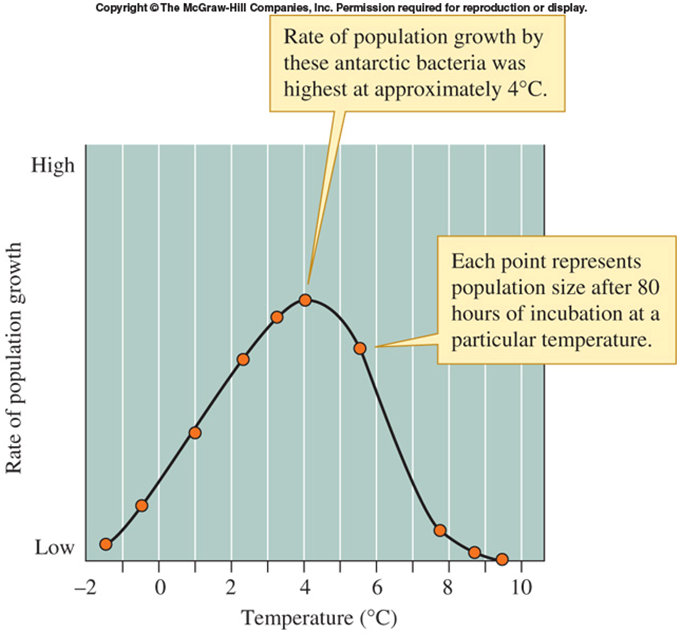
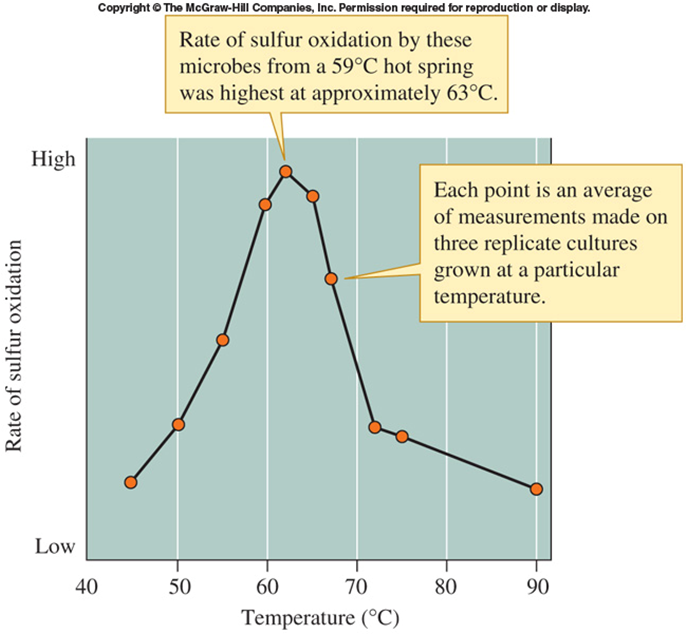
Different individual organisms adapt to different temperature regimes. The top left graph indicates the functionality of an enzyme in trout adapted to a water temperature of 2 degrees C versus one adapted to 17 degrees C. The enzyme functions the same, but is structured slightly differently in the two different fish, such that the version at 2 degrees C works best at 2 degrees C (and is nearly non-functional at 17 degrees C), and the version at 17 degrees C works best at 17 degrees C (and is completely non-functional at 2 degrees C). So the same enzyme may be modified to work best at appropriate temperatures. The second graph shows best photosynthetic efficiency at 15 degrees C in a boreal moss, and 44 degrees C in a desert shrub. The last two graphs indicate bacterial growth/metabolism in bacteria: growth in Antarctic bacteria is highest at 4 degrees C, and metabolism is most efficient at 63 degrees C from hot springs in Yellowstone National Park -- these last bacteria are even able to function (albeit slowly) at temperatures as high as 90 degrees C.
HEAT GAIN and LOSS Mechanisms
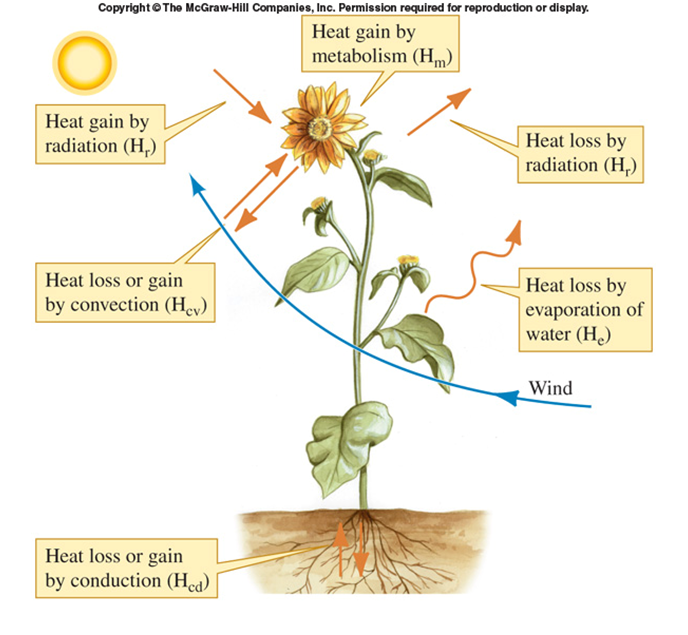
For organisms to function well, they must be able to balance heat gain and heat loss. Heat gain is accomplished in four ways for most organisms: metabolic heat gain (remember the second law of thermodynamics), radiative heat gain, convective heat gain (movement of hot gases/liquids around the organism -- think a hot bath), or conduction (heat gain from contact with a hot, solid surface). Heat loss happens also by four different mechanisms, three of which are the same as the gains: heat can radiate away, be carried away by cold moving gas/liquid (convection), be lost to a cold object the organism is in contact with (conduction; think of a cold seat at a football game), and then the fourth way is by evaporative water loss. So heat loss is also connected to water balance as well.
Convergent Evolution of Rosettes of high
altitude plants

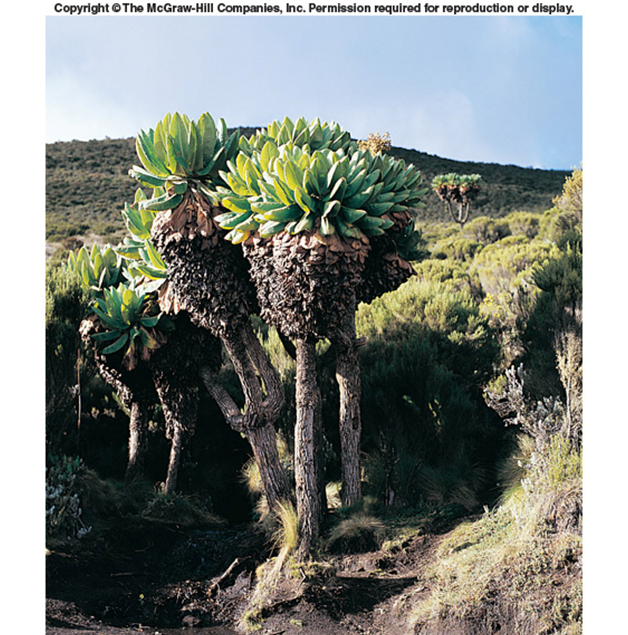
Pictured are two plants with similar form but unrelated, from the high Andes on the left, and from high elevation in Hawaii on the right. Both plants have a large stem with a rosette of leaves at the top. Many old bracts/leaves are retained just below the rosette. Thes plants are "tanks", in the sense that the large rosette can hold liquid water, which retains heat from the day. And the bracts/leaves at the base help shield the plants from freezing temperatures which therefore further help to retain liquid water. The leaves are typically pubescent (hairy) which helps them also retain heat from the day. And lastly, the leaves tend to reflect light inward during the day, which helps heat up the center/base of the rosette where the water is.
ECTOTHERMY
Basking
ENDOTHERMY
Muscular Thermogenesis -- Feralia major, a winter noctuid moth, exhibiting muscular thermogenesis; video courtesy of Colby McHenry,
Jan. 2017
Thermal Neutral Zones
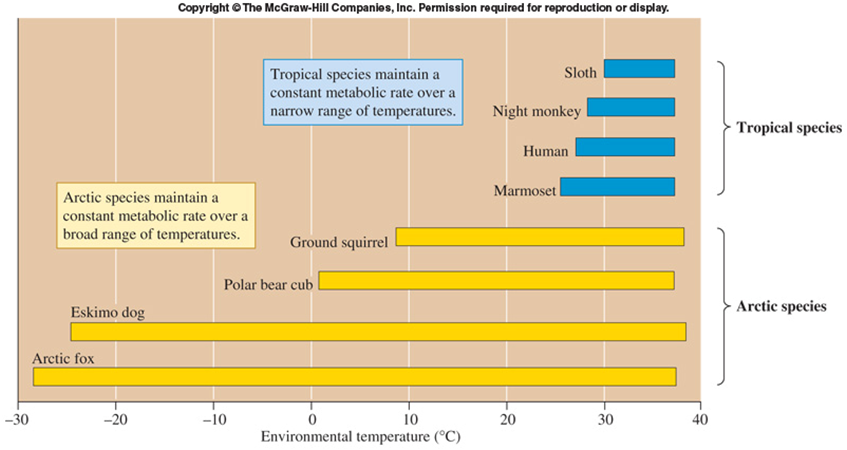
For homeotherms, in this case mammals, there is a certain range of temperatures over which they do not have to alter their metabolism to maintain their body heat. For those of tropical origins (that would include you!), the thermoneutral zone is rather narrow, in a range from the body temperature down about 10 to 15 degrees C below body temperature. So, for instance, the range of temperatures where you metabolism for generating heat is at it's minimum, is between about 80 and 98 degrees Farenheit. For Arctic species, the thermoneutral zone is amazingly broader, even for small species. A subarctic Ground Squirrel has a thermoneutral zone down to 8 degrees C (46 degrees F), and the Arctic fox has a zone that goes all the way down to minus 28 degrees C (minus 18 degrees F). The upper end for arctic species is around the same as tropical species.
SURVIVING TEMPERATURE EXTREMES
Plants
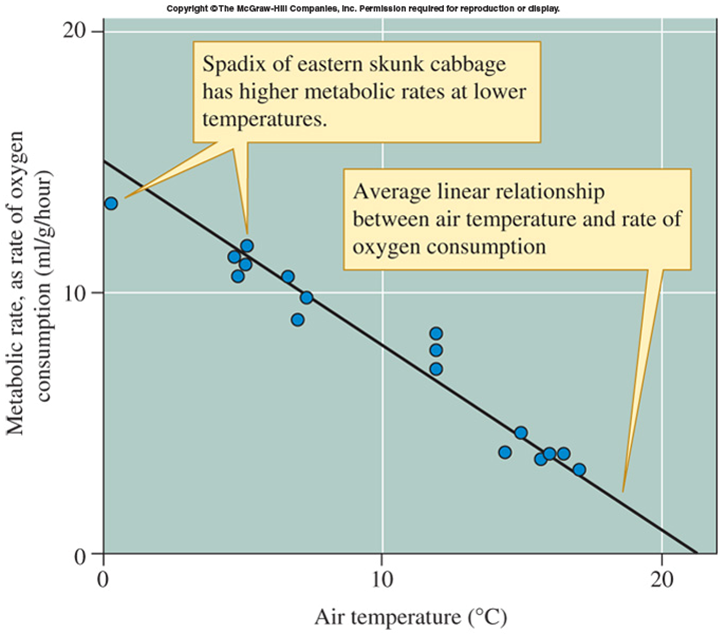
For the thermogenic plant Skunk Cabbage, it is able to increase it's metabolic rate to produce heat in direct relation to colder temperatures. At freezing it has a very high metabolic rate, enough to melt snow and allow it to grow before virtually any other plant is capable of growing in the Spring. As temperatures warm, it's metabolic rate goes down, as it does not have to produce as much heat to be able to grow.
Ectotherms

Not surprisingly, for ectotherms, such as the pictured Tiger Beetle, in early morning hours, almost all active individuals are in the sun. In this example, the temperatures of the sand are 30 to 35 degrees C (90ish degrees F). As the day progresses and the temperatures warm, more and more active individuals are found in the shade. Again, in this example, the sand temperatures can be VERY hot, around 70 degrees C (160 degrees F), which explains why most are in the shade. For those that ARE still in the sun on the sand, they stand very tall, with just the tips of their feet touching the sand and the body far off the ground.
Endotherms
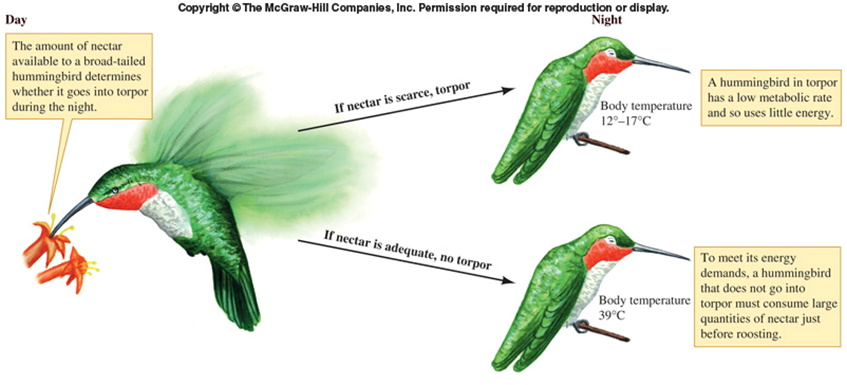
For endotherms, getting enough food to maintain a constant body temperature, can be an issue, especially if you rest/sleep during a colder night, even moreso if you are small. Hummingbirds are some of the smallest endotherms, and they burn energy quickly. If, during the day, they get adequate nectar to hold the body temperature through the night, then body temperature does not drop at night. If not, then they enter a state of TEMPORARY reduced body temperature called torpor. This conserves energy at night, although makes them more vulnerable to predators in the early morning, as their temperature must come up due to the sun and warming temperatures before than can adequately move around.